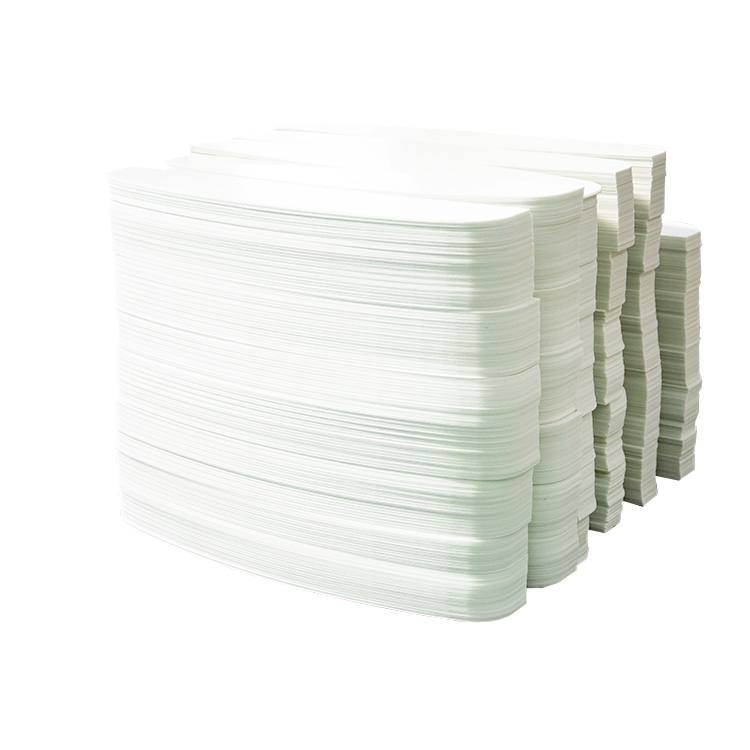Application of GMT materials
GMT is a new type of thermoplastic polymer composite material with good strength and stiffness, a small coefficient of thermal expansion and contraction, and strong impact resistance, especially exhibiting excellent stability under high-speed impact . Therefore, it is an ideal substitute for existing PVC and PP plastic formwork. Since the successful development and preparation of GMT materials, their excellent performance characteristics have been gradually recognized. To date, GMT materials have been widely used in various fields, including automotive, packaging, construction, transportation, and electric power industries .
The application of GMT materials in the packaging industry is mainly as packaging material. Compared with traditional packaging materials such as wood, metal, and ordinary plastics, it has the advantages of being lightweight, high-strength, corrosion-resistant, easy to process and form, recyclable, and having a low overall cost.
In the automotive sector, GMT materials primarily offer the advantages of being lightweight and having high impact strength, a simple molding process for products, and a short production cycle. Using GMT plastic sheets as a carrier for front-end assemblies in automobiles provides excellent rigidity while being very light, reducing the overall weight of the vehicle. Due to the one-piece molding process of GMT materials, many car companies have adopted GMT materials for front-end assembly carriers, which can integrate many different components at the front of the car [38]. Many foreign car models use GMT materials for components such as car bumpers, instrument panel carriers, and seat frames, as shown in Figure 1-3, which illustrates classic applications of GMT materials in the automotive industry. Using GMT material for car seat frames can greatly reduce the vehicle's body weight. GMT materials are compression molded, allowing for the rapid and mass production of car frames. With these advantages, GMT materials have immeasurable potential in the automotive field.
(1) For Front-End Modules
As early as the 1990s, GMT materials were used in the manufacturing of automotive front-end modules, and their usage now accounts for 28% of the total vehicle materials. The advantage of GMT material is that it is 20% lighter than steel of equivalent strength and can integrate functions such as headlights, radiator supports, bumper mounting points, and hood latches. This reduces the number of corresponding parts, simplifies the processing steps, shortens production time, and lowers production costs. Furthermore, GMT materials perform well in terms of stiffness, sound insulation, heat and corrosion resistance, and shock absorption. Currently, using GMT materials for automotive front-end modules has become the preferred choice for major car companies.
(2) Seat Frames
The European company EKT has established a production line for GMT seat shells, with GMT seat frames accounting for 20% of their total output. The surface of GMT seat frames can be produced in different colors and covered with various decorative elements, resulting in an attractive appearance suitable for seatbacks.
(3) Bumpers
The United States has widely adopted GMT for car bumpers. The current trend is to create unidirectional bumpers from several layers of unidirectional GMT. These bumpers offer better performance, good stiffness at low temperatures, are lightweight, and have good energy absorption and accident safety performance. They possess excellent elasticity, impact resistance, and toughness. The molding speed is 75% faster than for SMC bumpers, leading to high processing efficiency and reduced costs, while meeting the high strength and stiffness requirements in the direction of stress.
(4) Non-Structural Parts
The use of GMT in non-structural parts is also continuously growing. GMT sound insulation panels are used, primarily leveraging GMT's impact resistance and low-temperature performance. GMT instrument panels can integrate the support for gauges, airbags, and the heating and ventilation system. The British company Telford uses GMT to manufacture belt covers that can withstand high engine temperatures and vibrations.
In the automotive sector, with growing environmental awareness, the recycling and reuse of GMT materials are particularly important. Due to its high-quality recyclability, GMT sheet material is favored by many companies. For example, the company Plastics recycles and reuses scrap from GMT sheets by mechanically crushing the scraps and then extruding the crushed material into pellets for subsequent injection molding.
GMT materials can also be applied in aerospace materials. In new fighter jets in Europe and the United States, 85% of the materials used in the fuselage frame panels are carbon fiber and glass fiber composites, and GMT material is used for the leading edge of the wings. The European Airbus A380, the world's only double-decker, four-aisle passenger aircraft, can accommodate 555 passengers. The upper fuselage of this aircraft uses a multi-layer composite material alternating between aluminum sheets and high-strength glass fiber thermoplastic laminates, which saves 800 kg in weight compared to traditional materials.
The application of GMT materials in the construction industry is mainly as building formwork. Formwork made from this material can be reused multiple times, which brings significant advantages to the construction industry with its increasingly stringent environmental requirements. It can be considered a green and environmentally friendly building material. Moreover, the lightweight nature of GMT material brings many conveniences to construction. Therefore, this GMT material has great practical value in the construction field. Table 1-1 provides a performance comparison between GMT formwork and traditional material formwork, fully demonstrating the advantages of GMT formwork. GMT formwork has the advantages of high strength, corrosion resistance, wear resistance, ease of storage, and resistance to permanent deformation, which greatly increases the number of times the formwork can be used. It can generally be reused 15 times without applying a release agent. GMT formwork is relatively light, being 20% lighter than ordinary wooden formwork, which significantly reduces the labor intensity for workers and increases construction speed. The surface of GMT formwork is smooth with high flatness and does not easily adhere to debris. It has a low coefficient of thermal expansion, making the formwork easy to demold with good release properties.
Reinforced concrete structures are the common construction for current buildings, especially for high-rise buildings, where more than four-fifths of the structure is concrete. When constructing high-rise buildings, the process for using plastic formwork is as follows: first, the plastic formwork is assembled to the designed dimensions and structure, followed by a quality inspection. Then, the pre-mixed concrete is poured into the formwork cavity. After the concrete has cured and formed, the plastic formwork is removed. In the actual construction of buildings, column formwork is installed first, followed by wall formwork, then beam formwork, and finally floor slab formwork. These multiple formwork structures can be installed simultaneously or sequentially. This allows for the rapid and convenient completion of building construction, saving time in the construction project schedule. In the construction industry, especially for high-rise structures, reinforced concrete must be used for structural support. When building high-rise structures, a fixed-size plastic formwork structural frame needs to be constructed and its stability and safety checked. Subsequently, the prepared concrete is poured into the fixed plastic formwork cavity. After the concrete solidifies, the plastic formwork is dismantled. This method enables rapid building construction and significantly shortens the construction period.
Although GMT plastic formwork is highly functional, many technical details require attention during its application. From the selection of the formwork material, to its preparation, installation, and removal, and finally to its reuse, every step is closely related to the rheological properties, mechanical properties, and weather resistance of the formwork material. Therefore, improving the performance of GMT plastic formwork materials and ensuring collaboration between R&D personnel and trained construction workers are necessary to fully leverage the safety, convenience, and economic advantages of GMT plastic formwork.
Adding other modifiers to the GMT plastic formwork prepared from GF/PP composites can improve the quality of the plastic formwork [39]. For example, adding talc or mica powder can improve the surface smoothness of the plastic formwork, allowing for dismantling without the use of a release agent. This is especially beneficial in high-rise buildings, where the ability to dismantle formwork without a release agent significantly enhances worker safety.
Although GMT plastic formwork materials are widely used domestically, the advanced technology is still in the hands of some large foreign companies. As mentioned earlier in the research progress on foreign plastic formwork, the GMT building formwork prepared by some of these companies can be used more than 50 times, which is more than double the lifespan of domestically produced GMT plastic formwork.
In addition to the excellent performance of GF/PP plastic formwork material, the following aspects must be properly managed when it is used as building formwork: First, before installing the plastic formwork, the installation position must be accurately determined in advance. Spaces for water pipes and electrical circuits need to be reserved to prevent rework and an increase in the construction period. Second, joints in the plastic formwork are prone to slurry leakage. Tapes or adhesives should be used in advance to seal them and prevent leakage without affecting the stability of the formwork frame. Verticality, dimensions, and structure must also comply with relevant regulations. Third, after the plastic formwork is assembled, a quality inspection must be carried out before pouring concrete and installing floor slabs to promptly avoid any abnormal situations. Fourth, when construction personnel are working with the formwork, they must pay attention to the order of installing and dismantling the plastic formwork for walls, ceilings, etc. The height of the formwork should not be too great, and personnel must also take safety precautions, such as wearing safety helmets and harnesses. Fifth, dismantling the plastic formwork must only be done after ensuring the concrete has fully cured and formed. A release agent can be sprayed on the plastic formwork before pouring the concrete to improve demolding efficiency. Violent dismantling of the formwork is prohibited, as the resulting structural deformation is detrimental to stability. Sixth, since PP plastic has high tensile strength but a low elastic modulus, structural deformation of the material should be monitored during use. Steel structures can be added to the formwork to increase its strength. When the formwork has been used many times, it should be scrapped to prevent construction accidents. Seventh, GF/PP plastic formwork is greatly affected by temperature and deforms significantly when heated. Therefore, attention must be paid to the heat generated during concrete hydration. When excessive heat is generated, the plastic formwork can be appropriately cooled with water. Based on the estimated temperature conditions, suitable plastic formwork dimensions should be selected to reduce dimensional and structural errors.




